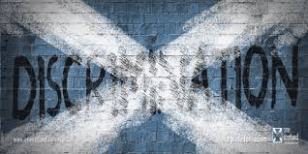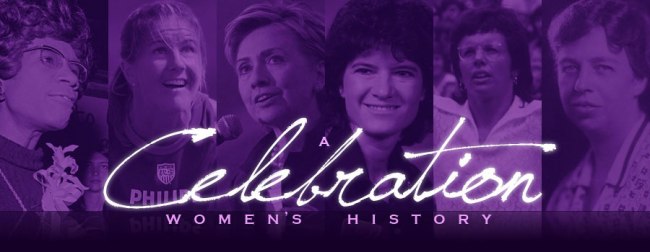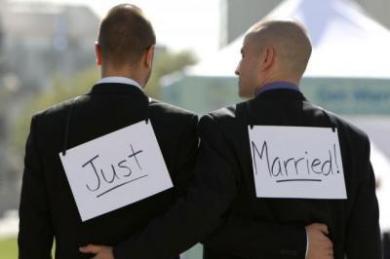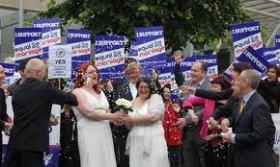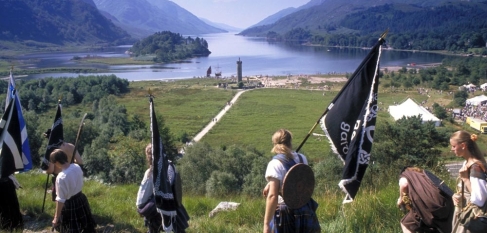November 22, 1995
…Scotland is as much of a country as England; more of a country than Wales, which is a principality; far more of a country than Ulster, which is a province; but less of a country than the United Kingdom, which is a sovereign state, and hence, unlike Scotland, able to pass the final test and compete in the Eurovision Song Contest. (Geographical Magazine 13)

Scotland is a sub-nation, a grouping buried within the British state. Exactly how much so is debatable, but much can be traced through history. In 1603, England and Scotland were united under one monarchy with King James (VI of Scotland, I of England). The monarch was supposed to remain non-partial to either side, but relations were stressful in the late 1600’s, as King William, having various powers of both Parliaments, increasingly favored England over Scotland. These tensions, the near bankruptcy of the Scottish nation, and other factors spawned a drastic agreement. In 1707, Scotland ceased to be an independent nation-state, and has not been one since it signed the Treaty of Union that year.

While uniting Scotland with Wales and England, the Treaty of Union made various provisos especially for Scotland, exceptions to central control which mostly remain to this day, covering Scots law, the Presbyterian Church of Scotland, and the system of local authorities (called the Royal Burghs then). This paper will examine how Scotland fits within the political system of the UK. In so doing, it shall explore the autonomy of Scottish law, the workings of the Scottish Office and Secretary, the Scottishness of the Westminster Parliament, and then explore the distinctiveness of Scottish culture, ending by examining the general political culture of ‘North Britain,’ focusing on the Tory regime since 1979 in particular.
Legal System

Scots law was one of the protected areas of Scottish control in the Union treaty, and remains so to a certain extent to this day. There was an essential divide between private and public law, the former allowing particularly Scottish arrangements, the latter being reserved for the British Parliament. The divide has not always been faithfully held, but the power ultimately lies in Parliament, as there is no room for judicial review of laws through the treaty, as might be offered by the Supreme Court of the United States. The closest available equivalent would be the International Court of Justice. Cases involving states’ internal affairs have only recently begun being heard by the court, and Scotland may yet have an opportunity to pursue this course of action in the future.
The Secretary of State of Scotland generally oversees the appointments of judges, and is responsible for the staff and administration of the two Supreme Courts, and the lesser Sheriff Courts. The two Supreme Courts are the criminal High Court of Justiciary and the civil Court of Session. Problematical is the fact that political leaders have so much control and influence over the judiciary.
It is the Lord Advocate and the Solicitor-General of Scotland who are the chief legal advisers to the Cabinet and government on Scottish issues, and the main “representatives of the Crown for the purposes of litigation in Scotland.” Like the Secretary of State, both are government ministers. The Lord Advocate is also responsible for drafting most legislation relating primarily to Scotland and for converting other primary legislation for Scottish administration.
Part of the difference between Scottish and English law is in its origins. Scottish law is derived from Roman law, which is based on legal codes: statutes are passed, and judges find points within them to cover the cases they hear. The English is that of common law, in which judges look to precedents in order to find the correct ways to rule in cases brought before them. Scots law, as such, is more compatible with the rest of the EU, as Roman law is typical to most of continental Europe. English law finds more parallels in places such as North America. (Rasmussen 196)
This engenders one of the most pervasive reasons behind a separate polity, since different laws require different administration. The laws, and the interests in them, cannot be simply assimilated, and they contribute to the general separation across the borders, through the administrators and politicians who have to work with them.
Since it is difficult to find MPs with Scottish legal qualifications, those that do have them are in a position to reap more rewards. One of the many arguments in favor of a devolved Scottish Parliament would be to engage more Scottish lawyers in the legislative process. (84)
The Scottish Office and Secretary
The highest Scottish official in the UK is the Secretary of State for Scotland. The Secretary is supposed to be Scotland’s representative to the Cabinet, and is the head of the Scottish Office, centered in Edinburgh (the old Scottish capital). When there is a specifically Scottish characteristic in a government function, it will tend to fall under the domain of the Scottish Office; otherwise, it remains the prerogative of a UK department. Of course, the division of functions between the Scottish Office and the center are all too ambiguous.
Within the Scottish Office are numerous departments and bureaucracies dealing with the region. The five main departments are: (1) Agriculture and Fisheries; (2) Environment, which not only covers ecological issues, but also local government, housing, building controls, land planning, and historical site preservation; (3) Education, which encompasses the arts, libraries, museums, galleries, sports, and Gaelic language, as well as general schooling; (4) Home and Health, which covers law and order, the National Health Service (NHS), fire, civil emergencies and social work; (5) Industry, overseeing transportation and roads, tourism, economic planning, European interests, employment and training, energy, and urban regeneration. (Reference 14)
The Secretary oversees massive expenditure, and his budget is constantly on the rise. The planned expenditure for regular services was just under 8.1 billion pounds for fiscal year 1993-4. Adding in the paltry grants from the European Regional Development Fund (NOTE: to be further discussed in my third essay) and a substantial amount of support from the Central government to local authorities, the Secretary becomes responsible for roughly 13.5 billion pounds. (Reference 17)
The Secretary plays an interesting role as a consular representative of sorts, representing Scotland in Westminster, and Westminster in Scotland. The Secretary does not represent the party of majority in Scotland, but that of the majority in Westminster. Thus has it been found at various times, especially in the modern era, that Scotland is ruled by a minister whose party has a minority of seats in Scotland. However, the system still functions, because the major parties accept his legitimacy, giving the Secretary the contingent power to represent Scotland, and to shape the ruling party’s policies for consumption in Scotland. (Kellas 28) While he is the target of a wide range of pressures, he is still merely a tool and executor of the policies of the British Cabinet, where the power truly resides.
Scots are no fools in this respect. Although few may know much as to how much decentralization is actually in effect, they are well aware that, despite the measures and gestures, supreme power still resides in Westminster. While Scottish Secretaries might be view as hard-working ministers, they are never perceived as powerful ones.
Secretaries are usually not found to be prestigious ministers. Having to spend a fair amount of time in Edinburgh rather than in London, and on Scottish debates rather than interacting with English MPs in the House of Commons, eliminates most opportunities for making a good showing in Westminster and the possibility of achieving real popularity is nearly non-existent; and, on the whole, Conservative Secretaries have tended to be more upwardly politically mobile than Labour ones. Despite the fact that there is little Conservative MP support in Scotland, the Secretaries have tended to carry significant weight nonetheless, mostly through alliances with more powerful ministers.
Although Cabinet is the main arbiter of power, its committees often make decisions which go on to be simply ratified within the full Cabinet. Membership on these committees is important, and rates a minister on his or her standing within the Cabinet. Some of the less prestigious Secretaries have been excluded from the important Economic Policy Committee, such as William Ross, and all are almost always left out of the Foreign Policy Committee. (Kellas 46) This may be an oversight, since Scotland has such a vested interest in foreign trade, in particular with EU policy. However, it is arguable that these interests are served already through Scottish representation to the Committee of the Regions and such lobbying groups as Scotland Europa (to be further elaborated in my third essay).
Conservative Secretaries have usually tried to work in the interests of Scotland, in order to make up for their party’s poor representation there. Labour ones, on the other hand, tend not to be so sympathetic. The supposed new policies of Tony Blair’s Labour party notwithstanding, old Labour was more concerned with socialism and social justice for the whole of the UK, and were decidedly adverse to the nationalist question.
The attitude of Secretaries of both parties are distinctly different. Labour ones, while knowing Scotland well, tend to treat it in the manner of a schoolmaster; they take an elitist approach, since they feel that they know what is best for their pupils. Conservatives tend to be less sure of themselves, but have greater social contacts. Despite being heavily Anglicized, they retain great pride in their country. It is useful to note that a great proportion of the bolstering of the Scottish Office’s power has come under Conservative governments. (Kellas 44)
A peculiar danger for the Scottish Secretary is the breadth of his field. The Secretary is responsible for most functions Scottish, and as such can easily overlook areas within his jurisdiction and responsibility if they do not tickle his fancy, or if he has little knowledge of them. The junior ministers in the Scottish Office take on as much responsibility as possible to aid the Secretary.
Parliament

Queen Elizabeth II opens parliament in Scotland
Parliament tends to give little hearing to Scottish issues in its main sessions. However, Scottish affairs are discussed in special committees. These have tended to be staffed predominantly by Scottish MPs, but they have been offset in the past by other MPs of the governing party, in order to retain its majority status on the committees.
The Scottish Grand Committee, consisting of all 72 Scots MPs, mulls over most bills exclusively Scottish on their second reading, and debates the finance of the Secretary of State and the Scottish Office. There are also two Standing Committees, which do a clause-by-clause examination of bills; one gets the most important bills, the rest being relegated to the second committee. There is also a Select Committee on Scottish Affairs, formed for the purposes of investigation and retaining the power to review witnesses and documents.
Since Scots are required on these committees as well as on others throughout the Commons, they are often stretched thin, and overworked. In particular, Scottish Tories are under considerable strain; since there are so few, they are needed all the time to maintain the government majority on the Scottish committees. As a result, they do not have as much time as they might like for other committees.
The Scottish content is rarely exciting. The Grand Committee gets bills that are uncontroversial within the ruling party and don’t affect England. Local administration figures high on the list. Dynamic debates are in short supply, and most importantly for the overall scheme, the stakes are much lower, because the Grand Committee cannot undertake a vote of confidence in the government (Kellas 92)
While the Scottish Committees have elevated the status of Scottish MPs, they still carry little weight in the Commons as a whole. There is considerable regional rivalry within the Parliament, and English MPs will always prefer to avoid discussion of Scottish issues or to avoid listening to the Scottish MP speeches.
A Distinctive Culture
The arts are many, varied, and distinctive in Scotland. The Scottish Arts Council, a bureaucratic representative of the Arts Council of Great Britain, is the primary distributor of government funds to support the arts in Scotland.
Opera, ballet, and orchestras, all have national Scottish companies which maintain a sizable international following. The Council funds writers in order to encourage a Scottish literary presence; public libraries are everywhere. The Scottish Film Council promotes domestic films, and supports production in Scotland along with the Arts Council. Then there are the National Museums of Scotland and National Galleries, whose government funding amounted to approximately 23 million pounds in 1992-3, and whose visitorship in 1991 was over 1 million and about 700,000 respectively. There are also innumerable thriving municipal collections, which in 1992-3 received 675,000 pounds from the Scottish Museum Council. (Reference 85)
Festivals of art and music are held around the year across the region, from large municipal festivals such as the August Edinburgh International Festival of Music and Drama, to amateur arts festivals such as the National Gaelic Mod, which celebrates the Highlands’ arts. (Reference 83)
Most of the newspapers published out of London (the Times, Star, etc.) are obtainable in Scotland at the same time, but their real circulation is far more limited than in the other regions of the UK. There remains a distinctive and diverse Scottish print media which garners much of the public attention, and prevents “the homogenizing effect of the [London] press on political opinion in the United Kingdom.” (Rasmussen 49) The most popular of these dailies are the Herald and the Daily Record , printed in Glasgow, and the Scotsman , printed in Edinburgh.
Radio and TV are also of a regional bent. The British Broadcasting Corporation (BBC)operates both radio and TV stations specifically within Scotland. These stations offer a wide variety of Scots programming, as well as bringing a portion of Scottish content to the national networks. Commercial television services are operated regionally by the Independent Television Commission (ITC), with separate centers in the Glasgow and Edinburgh area (Scottish Television), the north and east (Grampian Television), and the borders, which encompasses both the Scottish and English sides.
Sports are also of prime importance in Scotland. Over 35 clubs compose the three divisions of the Scottish Football League. The Glasgow Rangers have consistently made a premier showing, and gone on to perform well in UK and European wide competitions.
Rugby is also popular, and is played at national and district levels. The Five Nations Rugby Cup (between France, Ireland, Wales, England and Scotland), contested annually, has usually seen the Scottish national team in the front running. This past year saw the Scots ground down only in the final game against England, thus coming second place. The Government, in 1991, earmarked 2 million pounds to the Scottish Rugby Union, to improve the stadium in Edinburgh used for international matches. (Reference 92)
The Highland Games are what Scotland is best known for on the international sports scene. These take place at various centers over the summer, and include traditional sports such as the caber toss, shotput and hammer throw, plus piping competitions, and lots of Scottish country dancing.
Scottish Political Culture
Up until the 1970’s, Scots maintained political interests similar to the rest of Britain, and were concerned mainly with British issues. This meant that most voted along similar patterns as the rest of the country. But that changed; the vote for the Scottish National Party (SNP) rose dramatically, and Labour was returned in a much stronger position than in England, so that they attained a majority in Scotland. Although in the October 1974 general election the Tories managed 16 MPs to the SNP’s 11, the Conservatives fell to third place with five percent less of the vote than the SNP. The April 1992 general election, though it saw decline in the popularity of the SNP (to three MPs), saw the Liberal Democrats take nine seats, the Conservatives 11, and Labour 49. Following the trend of voters in Scotland to use strategic voting to oust the Conservatives, it is foreseeable that the Tories could lose most of their remaining Scottish seats,in urban areas to Labour, and in others to the Liberal Democrats and SNP. This again raises the much-touted ‘Doomsday Scenario.’
Some say that part or all of the unpopularity of the Tories in Scotland pertains to their Thatcherite policies, which go against Scotland’s traditional consensual political culture. These commentators argue that the executive devolution of power to such quangoes as the Scottish Development Agency, and their success, signify the inherent consensualism in Scotland. Richard Finlay contends that, in fact, these institutions were “never democratically accountable” and that Scottish corporatism can be traced back to the 1930’s, when the political elite circumvented the demands for “democratic devolution” by instituting “administrative devolution.” Thus was there no empowerment of the citizenry. Government by committee became the aim, and the rise in power of administrative bureaucracies such as the Scottish Office fit this pattern without much exception. Finlay argues that Scotland has and continues to be ruled by bureaucratic elitism. (Finlay 110-1) As such, the rise of interest group politics is only natural as it is the only way for citizens to get onto the ‘inside’, which is the home of decision-making. “Interest groups acquire a special legitimacy in the absence of a parliament.” (Paterson 112)
It is precisely the approach forwarded by Finlay which animates the contentions made by Ian Holliday. He criticizes Kellas for accepting the administrative devolution to Scotland as positive. He finds that Thatcherism was an imposition of “alien policies” which the Scottish political system, as expressed by Kellas, did little or nothing to prevent. (Holliday 449) Holliday contends that it was the citizenry which showed the most opposition to the policies, and that the administrative defenders of Scotland, mainly the Scottish Office, were “often rather easily out-maneuvered.” Scottish limits on Thatcherism were thus at their minimum on the level of “policy initiative,” and maximal at that of “policy implementation.” (456)
Holliday, then, sees Kellas’ insistence on a Scottish political system at the formal level to be a farce, since it did little to further Scottish interests under the Tory government of the 1980’s. His belief in a Scottish political system rests on the grass-roots level, in the Scottish media, the indigenous protest and activist groups, and Scottish cultural expression in general, shown best through the resistance movement against the implementation of the Poll Tax. Thus did Thatcherism face a major challenge when confronted by this system, and, in Holliday’s opinion, lost. He claims that the Tories presided over and provoked the “decline in Scottish support for the British state.” (459)
The Lord Advocate, though mostly a glorified lawyer nowadays, played a much larger role in the past. In the eighteenth and nineteenth centuries, following the chaos of the Jacobite uprisings, and their final suppression in 1745, when the system of patronage was king in Scotland, Westminster simply ‘managed’ Scotland through the position of the Lord Advocate. Managers such as Henry Dundas, through patronage, controlled most of the Scottish MPs, and were able to steer their votes in whatever direction needed by the government. The “gravy train operated through Westminster,” and meant that all hopeful Scots were driven to climb the English ladder to power and influence. (Dickson 360) This concept of “territorial management,” has been a historic feature of the British political system as a whole, where the “periphery has been controlled through the colLabouration of the local elites.” (Midwinter 200)
Dickson addresses what Nigel Lawson termed the Scottish “culture of dependence” on the state, and what Dickson calls “reliance.” (Dickson 361) He cites that in 1986/87, Scotland received 22% more government funding than England on average. So, while many commentators pin the Conservatives’ unpopularity north of the border on economic factors such as Scotland’s massive contingent of heavy industry, which was hurt by the “de-industrialization of the economy,” Dickson notes that Scotland did in fact not fare too badly compared to other regions of the UK, and that the issue is a matter of policy. Scots, according to Dickson, have perceived the policies of Thatcherism as “especially inappropriate to the particular circumstances of their country,” where social need has always required a higher spending level. (363) The dismantling of Regional Aid, and the closure of many nationalized industries has propagated the view in Scotland that the Tories do not care about Scotland.
Scottish Protestantism, often cited as the basis for much of Scottish behavior, is also useful here when dealing with the distribution of wealth. While they see nothing wrong with accumulating wealth, Scots are disgusted by the flaunting of it, which is what they associate with the English, particularly Thatcher, John Major, and the Tories. (365) In keeping with this point, the Scottish kirk has recently come into greater conflict with the government.
Source: http://www.hfienberg.com/scots/490uk.html





